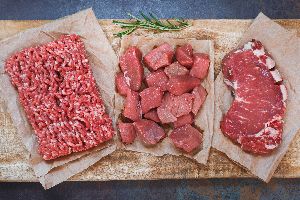
Shopping for food in today’s market can be overwhelming, especially for those of us used to reading labels diligently. Many of us want to know where our food comes from, how fresh, and what goes into it. But there is a lot of misleading and confusing information out there as well.
Organic versus all-natural, wet-aged versus dry-aged, grass-fed, pasture-raised, organic, and so many more labels can create confusion over what’s good.
When it comes specifically to grass-fed beef, is there truly a difference? Does it matter if your beef is grass-fed or not and how does that change, if anything, the beef you eat?
Difference Between Grass-Fed and Grain-Fed
In the USA, calves, born in the early spring drink milk from their mothers and then can roam free to eat grass or anything else edible in the field. After 7 – 9 months, most conventional cow farms move young cows into feedlots.
Large feedlots, also known as concentrated animal feeding operations, are very limited in space. Most cows are unable to turn around and are packed side by side together touching one another. They are then rapidly fattened by being fed grains from a base of soy or corn, with only a tiny supplement of dried grasses in their diet. They live a few months in the feedlots before being brought to a slaughterhouse.
While the labels mean something different depending on which country they are from, for example, grass-fed in Britain would not compare to grass-fed in the USA, and grass-fed does not necessarily mean pasture-raised. Many grass-fed cows may still live their lives within a feedlot.
However, the distinction is that grass-fed cows eat grass, fresh or dried, while grain-fed cows eat a mostly unnatural diet meant to pile on weight and quickly.
Different Fatty Acid Compositions
Just as the kinds of foods we eat affect how our bodies work, so too do the kinds of food cows eat affect their bodies as well. The nutrition quality that a cow eats can significantly alter the nutrient composition of its beef. The largest difference can be seen when it comes to fatty acid composition.
- Grass-fed beef contains much less monounsaturated fat than grain-fed beef.
- Both grain-fed and grass-fed have roughly the same amounts of omega-6 fatty acids.
- It is grass-fed beef, however, that has 5 times the omega-3 fatty acids of grain-fed.
- Grass-fed beef contains twice as much CLA (conjugated linoleic acid) as grain-fed beef and is associated with a few health benefits.
Omega-3 fatty acids are an integral part of the cell membranes throughout the body and affect the function of the cell receptors in these membranes. They provide the starting point for making hormones that regulate blood clotting, contraction and relaxation of artery walls, and inflammation. They also bind to receptors in cells that regulate genetic function, have been linked to preventing heart disease, stroke and may even help control lupus, eczema, and rheumatoid arthritis.
Conjugated linoleic acid, or CLA, is naturally occurring in meat and dairy and can help maintain weight loss, retain lean muscle, contribute to controlling type 2 diabetes, and may also contribute to fighting heart disease.
Grass-Fed Beef is More Nutritious than Grain-Fed
Both grain-fed and grass-fed have highly concentrated sources of nutrients. Both types of beef are loaded with B12, B3, and B6. They are also both rich in bioavailable iron, selenium as well and zinc. You will find high-quality protein in both grass-fed and grain-fed beef as well as lesser-known nutrients such as creatine and carnosine, which are crucial for muscle and brain function.
However, it is grass-fed beef that contains higher amounts of carotenoid precursors to vitamin A and vitamin E. Vitamin E is an antioxidant that sits in your cell membranes and protects them from oxidation. Grass-fed also turns out to be much richer in other important antioxidants.
Is Grass-Fed Beef Worth It?
In short: the added nutrients in grass-fed beef make it very worth adding to your diet if possible.
An important item to note is that the key to healthy beef, whether grain or grass-fed, is in the cut of the beef, the quality of the beef, and how it is cooked. It is crucial to never overcook beef for it to remain nutritious. You should never overcook beef because:
- Overcooked beef becomes harder to metabolize. It is more difficult to digest.
- Cooking beef too long results in a loss of important nutrients, as more chemical reactions in the beef occur.
- Once beef becomes too charred on the outside, the formation of certain carcinogenic substances begins to form which can contain dangerous cancer forming properties. Frequently consuming overcooked beef could lead to health issues.
While there is no concrete number as to how much charred or too-browned beef can consume before it becomes a health risk, it is always best to cook your beef until golden. Never cook until it is deep, dark brown, or burnt.
In the end, we believe the added benefits and nutrition from grass-fed beef makes it a cut above grain-fed.

